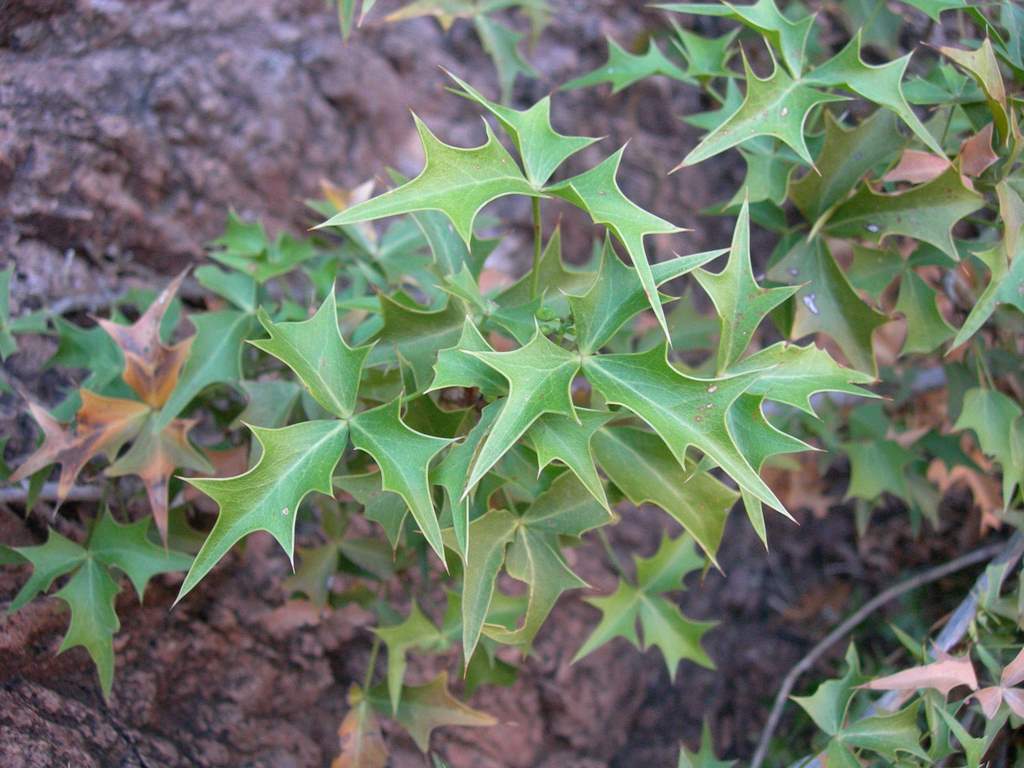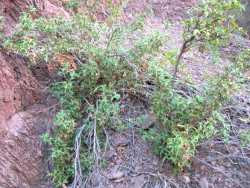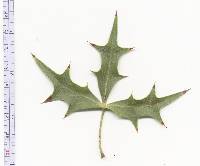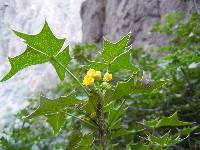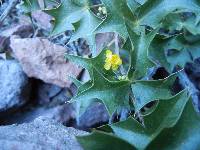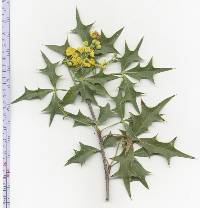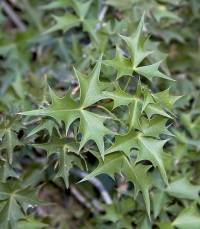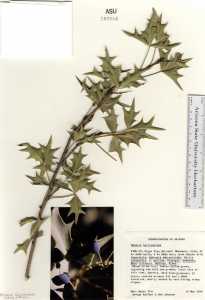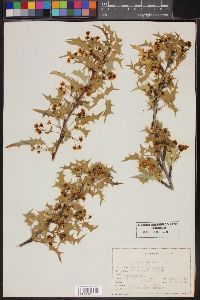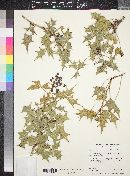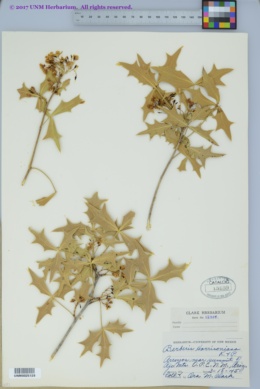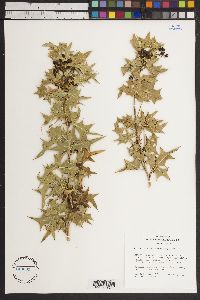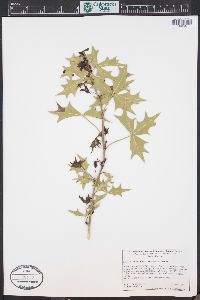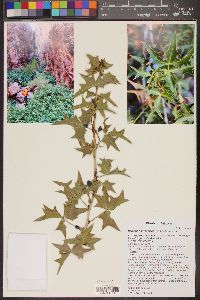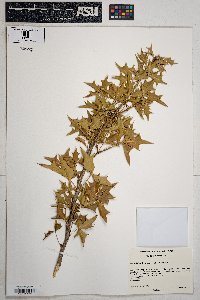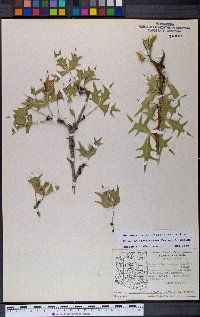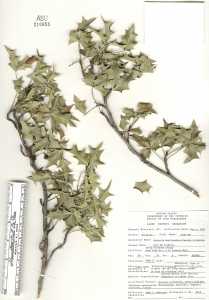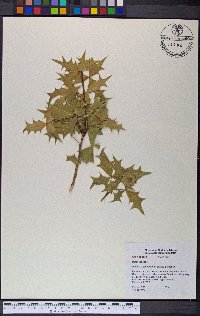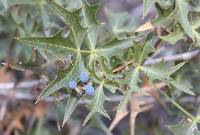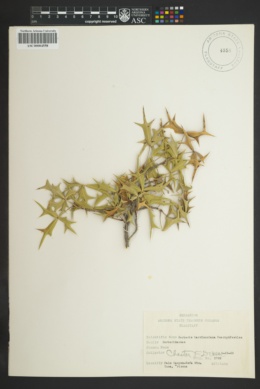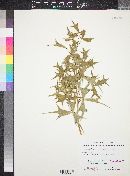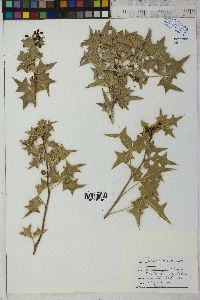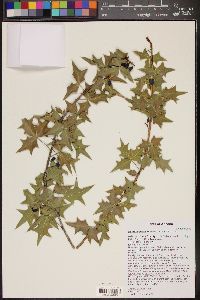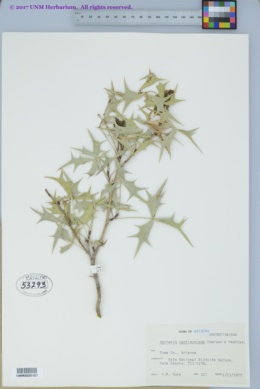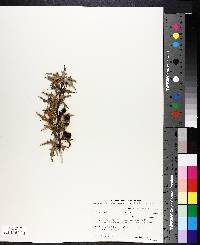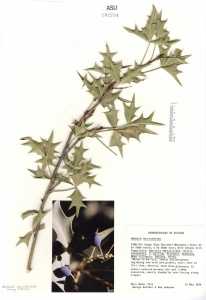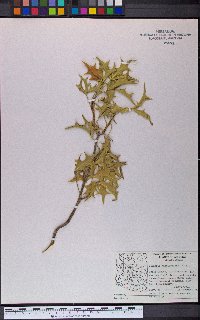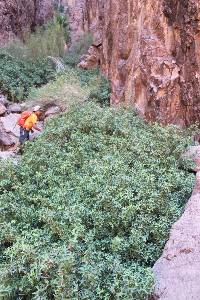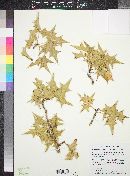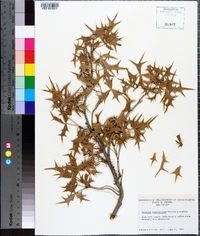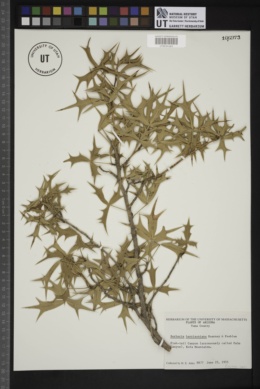Berberis harrisoniana
|
|
|
|
Family: Berberidaceae
Harrison's barberry, more...Kofa Mountain Barberry, Kofa barberry, red barberry (es: algerita)
|
Shrubs , evergreen, 0.5-1.5 m. Stems often ± dimorphic, with elongate primary and somewhat elongate axillary shoots. Bark of 2d-year stems brown or gray, glabrous. Bud scales 1.5-3 mm, deciduous. Spines absent. Leaves 3-foliolate; petioles 1.5-5 cm. Leaflet blades thick and rigid; surfaces abaxially ± dull, papillose, adaxially dull, rarely glossy, somewhat glaucous; terminal leaflet sessile, blade 2.9-5.4 × 2.2-3.2 cm, 1.3-2.4 times as long as wide; lateral leaflet blades ovate or rhombic to lanceolate, 1-3-veined from base, base acute to rounded-obtuse, margins plane or undulate, lobed, with 1-2 teeth 5-13 mm high tipped with spines to 2-3.4 × 0.3-0.4 mm, apex acuminate. Inflorescences racemose, rather dense, 6-11-flowered, 1.5-2.5 cm; bracteoles membranous, apex acute or obtuse. Flowers: anther filaments with distal pair of recurved lateral teeth. Berries blue-black, glaucous, spheric to short-ovoid, 5-6 mm, juicy, solid. Flowering winter (Jan-Mar). Shady spots in rocky canyons; of conservation concern; 800-1100 m; Ariz. Berberis harrisoniana is endemic to the Kofa and Ajo mountains. It has not been tested for resistance to infection by Puccinia graminis .
Plant: Shrubs 50-100 cm tall Leaves: trifoliolate, 4-9 cm long; petiole 1-4 cm long; leaflets oblong, elliptic, ovate or obovate, sessile, coriaceous, light green but usually not very glaucous, scarcely paler below, 2.5-5.0 cm long, 2.0-3.5 cm wide; veins prominent; teeth of leaflet margin 1-2(-3) pairs, triangular to attenuate, 6-20 mm long, each bearing a spine INFLORESCENCE: 2-4 cm long, corymbiform to racemose, 3-10-flowered; bracts green, acuminate, ovate to rhombic, 1.0-2.0 mm long; bracteoles 2, opposite or with one appressed to calyx and the other 2-4 mm below it, ovate to lanceolate, 1.0-1.5 mm long Flowers: sepals 9; outer sepals ovate, 1.5-2.0 mm long; middle sepals broadly ovate to lanceolate, 2.0-2.5 mm long; petals and inner sepals 6 mm long; stamens 2.5-3.0 mm long; filaments bearing 2 lateral spur-like teeth at apex Fruit: berries, globose to subglobose, black to dark blue, subglaucous, 5-6 mm long; SEEDS reddish-brown, fusiform, 3-5 mm long Misc: Mtn. canyons; 750-1050 m (2500-3500 ft); Feb-Mar REFERENCES: Laferrière, Joseph E. 2001. Berberidaceae. J. Ariz. - Nev. Acad. Sci. Volume 26(1). Kearny and Peebles 1979, FNA 1997 Common Name: Harrison's barberry Duration: Perennial Nativity: Native Lifeform: Shrub General: Evergreen shrubs, 0.5-1.5 m tall; stems often dimorphic, with elongate primary and somewhat elongate axillary shoots; bark of second-year stems brown or gray, glabrous. Leaves: Alternate and petiolate, the petioles 1-5 cm long; blades trifoliate; leaflet blades thick and rigid, ovate with undulate margins and spine-tipped teeth, the surfaces dull, somewhat glaucous; terminal leaflet sessile, blade 3-5.5 cm long by 2-3 cm wide; lateral leaflets sessile, blades 1-3-veined from base, base acute to rounded-obtuse, apex acuminate. Flowers: Yellow, 2 cm long, in dense racemes of 6-11 flowers, each flower subtended by 3 membraneous bracteoles; sepals 6, yellow, falling off after anthesis; petals 6, yellow, nectariferous. Fruits: Berries blue-black, glaucous, spheric to short-ovoid, 5-6 mm, juicy, solid. Ecology: Found in shady spots in rocky canyons, from 2,600- 3,600 ft (792-1097 m); flowers January-March. Distribution: sw AZ, se CA Notes: This is a species of conservation concern due to its rarity and restricted range. Berberis harrisoniana is endemic to the desert mountain ranges between Yuma and Phoenix in southwestern Arizona, plus one mountain range in neighboring southeastern California. It is most similar to B. trifoliata which also has 3 leaflets, but that species has leaves that are more conspicuously glaucous (covered with a waxy coating); terminal leaflets that are narrower, about 2 cm wide including the teeth (about 3 cm wide in B. harrisoniana); and red berries (blue-black berries in B. harrisoniana). All other Arizona Berberis have pinnately compound leaves with 5 or more leaflets. Ethnobotany: Unknown, but other species in the genus have uses. Etymology: Berberis is the Latinized form of the Arabic name for the fruit; harrisoniana possibly honoors John William Heslop Harrison (1881-1967), Professor of Botany at King's College, Durham University. Synonyms: Mahonia harrisoniana Editor: AHazelton 2015 |
|
|
|

